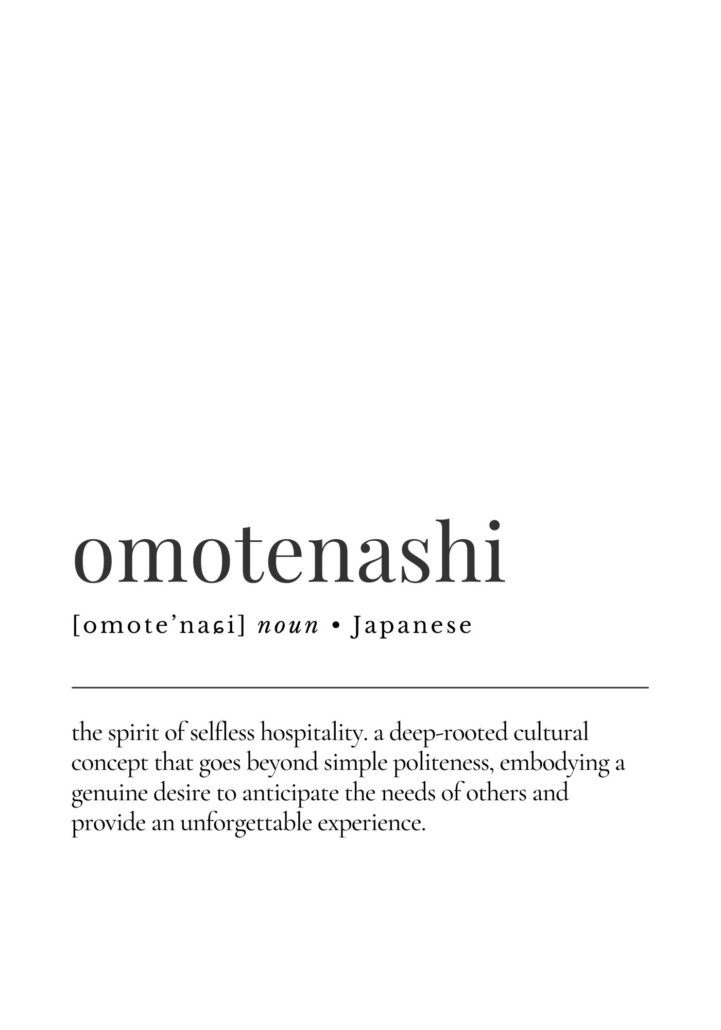There’s a Japanese word we carry close to our hearts, one that shaped the way we live, love, and work: omotenashi.
At first glance, it translates simply as “hospitality.” But anyone who’s lived in Japan, or been on the receiving end of true omotenashi, knows it’s much more than that. It’s not just service with a smile. It’s not scripted politeness. It’s a philosophy. A way of being.

What Does Omotenashi Mean?
The word omotenashi comes from the tea ceremony, where every detail is considered and nothing is left to chance. It’s about anticipating needs before they’re spoken, giving without expectation, and creating an atmosphere of care so seamless it almost disappears.
In Japanese, omote means “surface” or “public face,” while nashi means “without.” Together, they imply a kind of hospitality without pretense. A generosity that isn’t about performance, but about presence.
It’s not, “Here’s what we’re trained to do.” It’s, “Here’s what you need… and we’ll meet it, before you even realize.”
That’s the essence. And once you’ve experienced it, you never forget it.
The First Time We Felt It
We still remember our first brush with omotenashi when we arrived in Japan over two decades ago. Exhausted, jet-lagged, unsure of our Japanese, we stood at a tiny ramen shop fumbling over the menu. The owner didn’t laugh, didn’t rush, didn’t sigh. Instead, he quietly brought out two steaming bowls and placed an English dictionary beside them. No words, just thoughtfulness.
That’s omotenashi. A kindness without fanfare.
But Let’s Talk About Fake Omotenashi, Too
Of course, as with anything beautiful, there’s a shadow side. In a country where customer service is a national point of pride, not all hospitality is created equal.
Sometimes, omotenashi becomes scripted. A rehearsed bow, a standardized phrase, a layer of politeness that feels more like theater than care. It’s efficient, sure. But it misses the essence.
We’ve had those experiences too. The ones where you feel more like a transaction than a person. Where the performance is flawless, but the connection is absent.
And here’s the thing: that’s not bad service. It’s still miles ahead of what you might find elsewhere. But it’s not the heart of omotenashi. It’s the polished version without the soul.
Living the Difference
Living here, we’ve learned to tell the difference between the scripted and the real. And in our work, we’ve made it our mission to embody the latter.
Because weddings… like omotenashi… aren’t about surface. They’re about soul.
When we plan and photograph weddings, our service doesn’t stop at the logistics. It’s not just timelines and shot lists. It’s anticipating that a mother might need tissues before the vows begin. It’s making sure the groom has a quiet moment in a yukata before the storm of celebration. It’s noticing the grandmother might not be eating the Japanese ryokan breakfast and having her fridge stocked with a little fruit and yogurt.
It’s the things no one sees but everyone feels.
The Power of Anticipation
Real omotenashi is proactive, not reactive. And that’s where the magic lies.
When a guest arrives at a ryokan and slippers are already waiting in the exact right size… when a server remembers not just your favorite dish, but how you like it prepared… when someone moves a chair into the shade before you realize the sun has shifted… that’s not coincidence. That’s cultural DNA.
And that’s the philosophy we bring to every wedding. Couples often tell us afterward, “You thought of things we didn’t even know we needed.” That’s the point. Because service, when done right, isn’t about being seen. It’s about letting others feel seen.
Omotenashi in Weddings
Destination weddings are fertile ground for omotenashi. Guests are often navigating unfamiliar traditions, venues, or even languages. The difference between scripted service and true care is palpable.
We’ve watched guests fumble with chopsticks during kaiseki dinners… and has our servers appear with forks, unprompted, before anyone feels embarrassed. We’ve moved entire ceremonies indoors mid-downpour, so seamlessly that guests thought it had always been the plan. We’ve learned to tie together East and West, formality and play, tradition and modernity… all without calling attention to the work it takes behind the scenes.
Because that’s the heart of omotenashi. Not effort that demands recognition. Effort that dissolves into ease.
Why It Matters Beyond Weddings
The truth? Omotenashi isn’t just a wedding philosophy. It’s a life philosophy.
It’s in how you greet a neighbor. How you set a table. How you remember the details that matter to someone else, not because it benefits you, but because it honors them.
And yes, it’s in how you run a business. In a world obsessed with speed, scale, and “what’s next,” omotenashi teaches us to slow down, to care deeply, to focus on the one in front of us.
Our Promise of Omotenashi
We don’t get it perfect every time. We’re human. But living here in Japan has taught us that true service isn’t about perfection. It’s about intention.
It’s about the quiet extras… the glass of water handed over before it’s asked for, the camera batteries charged twice just in case, the planning spreadsheets color-coded not for us, but so couples don’t feel overwhelmed.
It’s about service without ego. Service that says, “This isn’t about us. It’s about you.”
And if we’ve built a reputation for anything, we hope it’s that. That our couples, their families, and their guests feel what we felt in that ramen shop all those years ago: You’re cared for. You’re seen. You’re safe here.
Because in the end, omotenashi isn’t a word. It’s a way of showing up… for each other, for strangers, for love.
And we’re endlessly grateful that Japan taught us how.
See a favourite 37 Frames wedding here: A celebrity wedding in Hawaii











